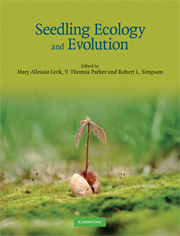Book contents
- Frontmatter
- Contents
- Contributors
- Foreword by Peter J. Grubb
- Preface
- Acknowledgments
- Part I Introduction
- Part II Seedling diversity
- Part III Seedling morphology, evolution, and physiology
- Chapter 5 Embryo morphology and seedling evolution
- Chapter 6 Regeneration ecology of early angiosperm seeds and seedlings: integrating inferences from extant basal lineages and fossils
- Chapter 7 Physiological and morphological changes during early seedling growth: roles of phytohormones
- Chapter 8 Seedling ecophysiology: strategies toward achievement of positive net carbon balance
- Chapter 9 The role of symbioses in seedling establishment and survival
- Part IV Life history implications
- Part V Applications
- Part VI Synthesis
- References
- Index
Chapter 9 - The role of symbioses in seedling establishment and survival
Published online by Cambridge University Press: 05 June 2012
- Frontmatter
- Contents
- Contributors
- Foreword by Peter J. Grubb
- Preface
- Acknowledgments
- Part I Introduction
- Part II Seedling diversity
- Part III Seedling morphology, evolution, and physiology
- Chapter 5 Embryo morphology and seedling evolution
- Chapter 6 Regeneration ecology of early angiosperm seeds and seedlings: integrating inferences from extant basal lineages and fossils
- Chapter 7 Physiological and morphological changes during early seedling growth: roles of phytohormones
- Chapter 8 Seedling ecophysiology: strategies toward achievement of positive net carbon balance
- Chapter 9 The role of symbioses in seedling establishment and survival
- Part IV Life history implications
- Part V Applications
- Part VI Synthesis
- References
- Index
Summary
Introduction
Seedling establishment is one of the key processes that determines the structure and diversity of natural communities. There are many factors that contribute to seedling establishment as explored in Pickett et al. (1987) and this volume. To date, little attention has been paid to the effects of mycorrhizal fungi on seedling establishment. However, there are several compelling reasons to consider these symbiotic fungi. First, the vast majority of all land plant species form symbiotic associations with mycorrhizal fungi and seedlings of most species become colonized by these soil fungi immediately after germination and root formation (Newman, 1988; Read & Birch, 1988; Wang & Qiu, 2006). Second, seedlings usually receive mineral nutrients from mycorrhizal fungi and often show enhanced growth when colonized. In addition, several studies report that mycorrhizal fungi can protect seedlings against drought and the harmful effects of pathogenic soil fungi and heavy metals. Third, many mycorrhizal fungi are not host specific and can colonize a wide range of plant species (Molina et al., 1992; Smith & Read, 1997; Opik et al., 2006). Due to this lack of specificity, seedlings can quickly become integrated into hyphal networks that are usually already present and maintained by the surrounding vegetation. Hence, in this way, seedlings have immediate access to a cheap nutrient absorption machine in which they do not need to invest resources (Newman, 1988).
- Type
- Chapter
- Information
- Seedling Ecology and Evolution , pp. 189 - 214Publisher: Cambridge University PressPrint publication year: 2008
- 24
- Cited by

